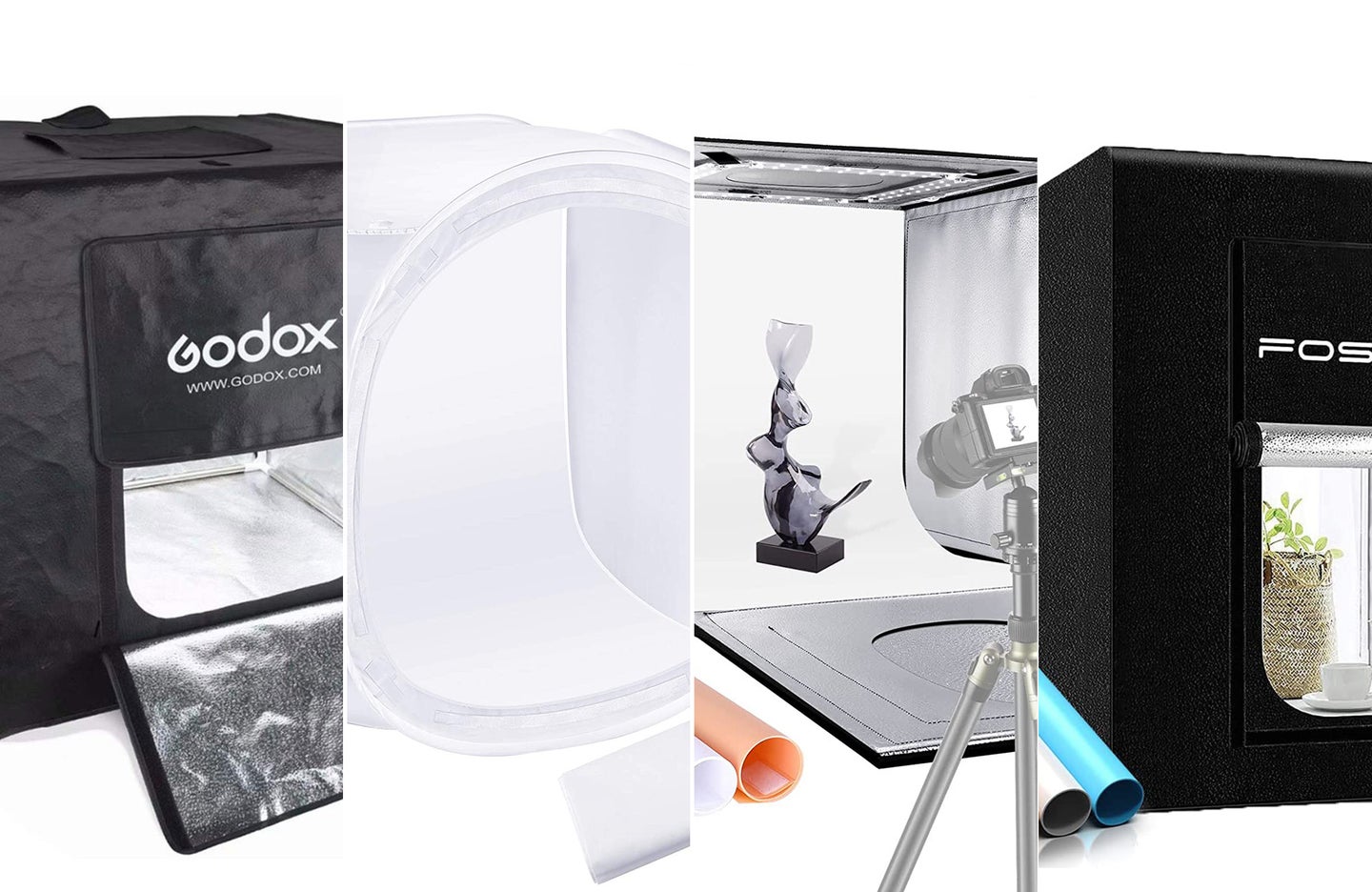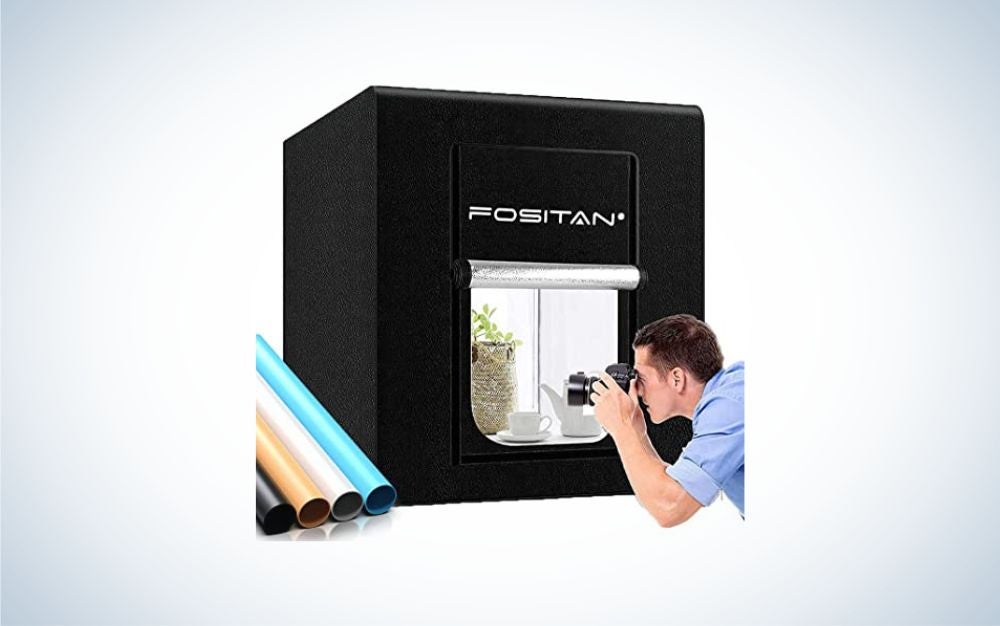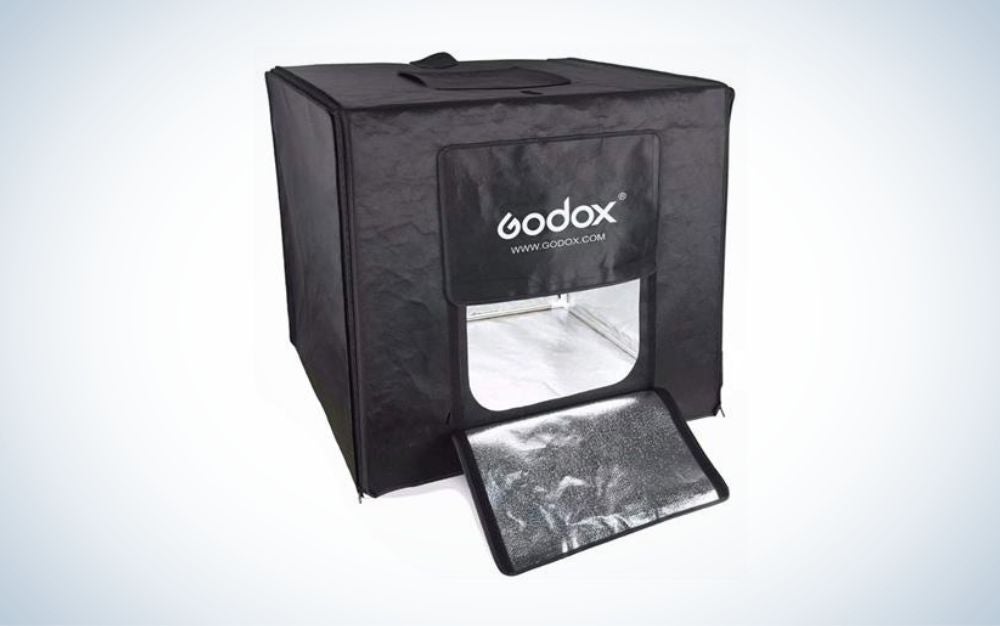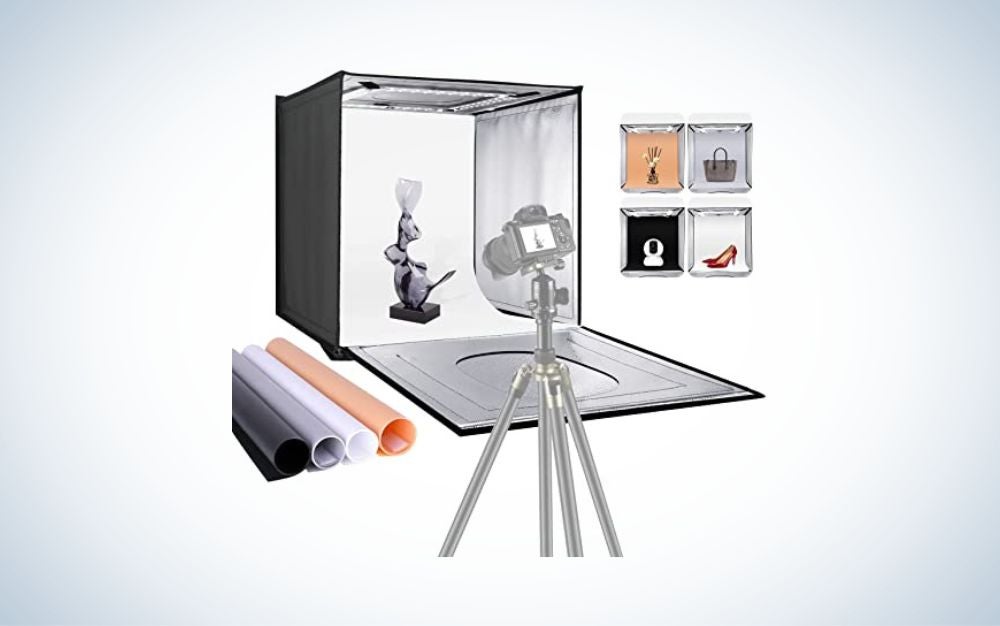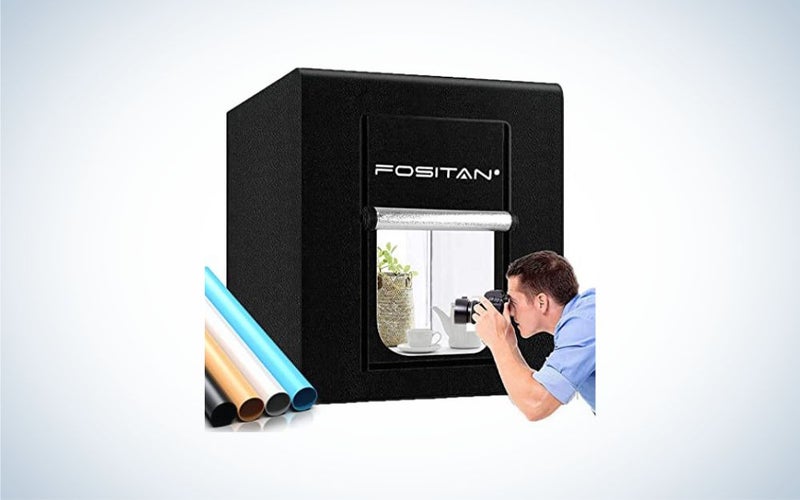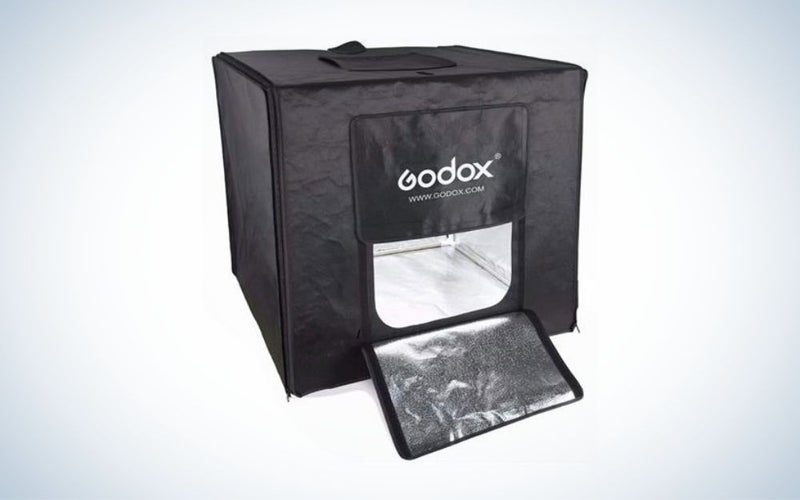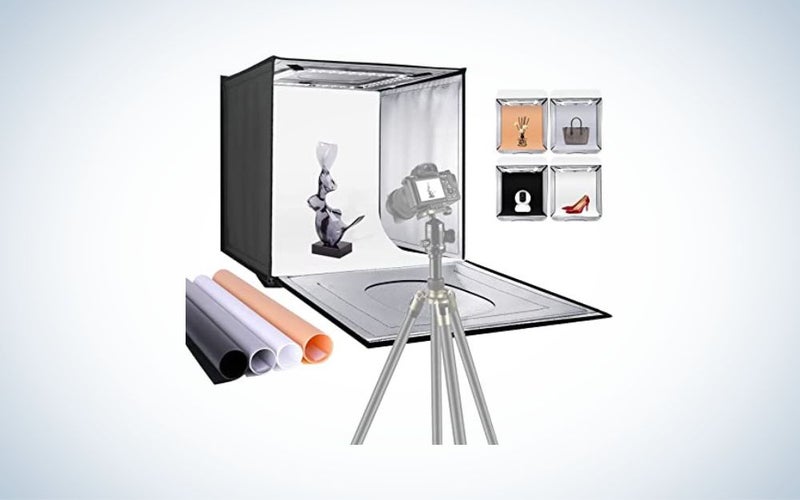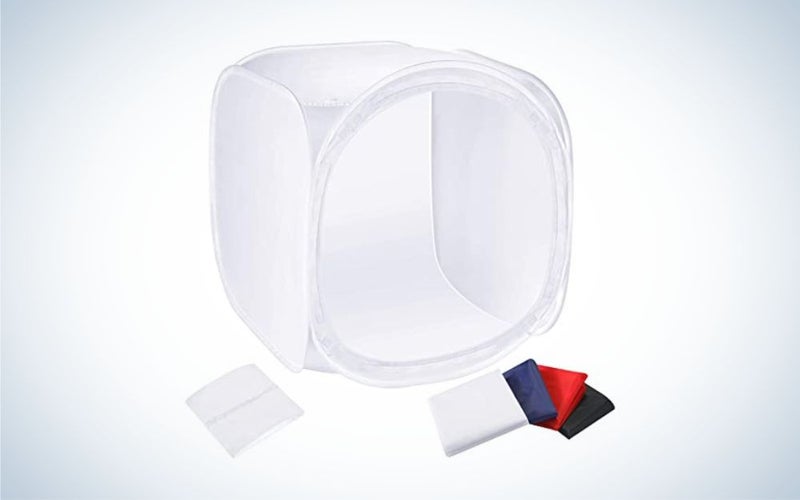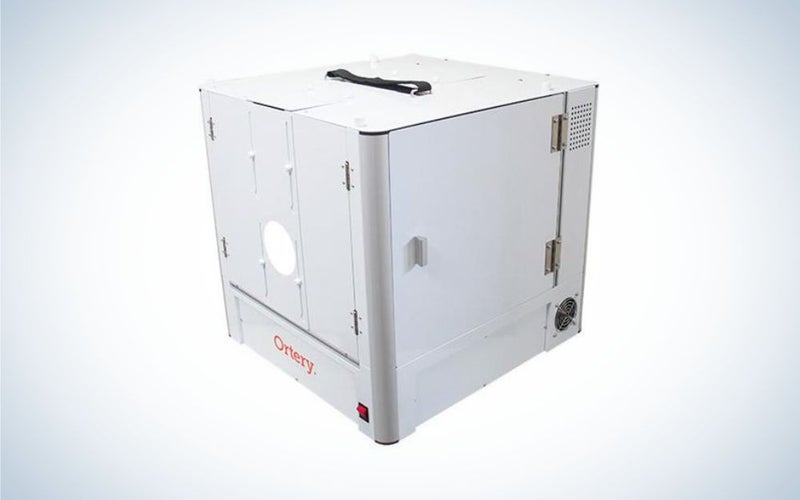We may earn revenue from the products available on this page and participate in affiliate programs. Learn more ›
A photo light box—otherwise known as a light tent or shooting tent—can make product photography a much faster and simpler process. These little boxes are essentially small studios with built-in backgrounds and light diffusion that creates even, hot-spot-free illumination on just about any object you can fit inside. They provide a professional look that’s easy to replicate. It makes a big difference if you’re trying to get into selling things on eBay, Facebook Marketplace, or any other online exchange. There are plenty of options on the market and some of them perform much better than others. We’ve curated this list of the best photo light boxes for simple, efficient still-life shooting.
- Best overall: Fositan Photo Box
- Best kit: Godox LST40
- Best value: Neewer Photo Studio Light Box
- Best portable: Neewer 24” x 24” portable
- Best for product photography: Ortery 2D PhotoBench 100
How we picked the best photo light boxes
I have been writing about and reviewing camera and photography equipment since 2008 for Popular Photography and a variety of other outlets. I’ve also sold tons of stuff online since the early 2000s. I curated this list based on personal experience, editorial reviews, user feedback, and spec comparisons.
I emphasized models that include their own sources of illumination and allow for swappable backdrops for extra versatility. We looked for rugged construction without making the entire package too heavy and hard to move.
The best photo light boxes: Reviews & Recommendations
Best overall: Fositan Photo Box
FOSITAN
Why it made the cut: With lots of room, built-in light strips, included backdrops, and multiple shooting angles, this setup has everything most photographers need.
Features:
- Size: 35” x 35”
- Light included? Yes
- Backgrounds: Interchangeable (four included)
Pros:
- Includes everything you need
- Stepless dimming with two light strips
- Durable construction
- Multiple shooting angles from the front and top
- Interchangeable backdrops with four included.
Cons:
- Bulky
Lined with reflective fabric, this photo light box includes a pair of LED strips that provide even illumination across just about any object that fits inside. The large 35-inch interior offers plenty of room, even for larger objects. The kit comes with four different backgrounds, including black, white, blue, and orange. You can also add more background color options to the setup with fabric or paper.
The included lights offer surprisingly powerful and color-accurate illumination that spreads evenly across the subject. It’s technically portable because all of the gear fits into a single long carrying case. But, it weighs more than 16 pounds, so it’s not the easiest thing to lug around.
Black outer walls make this box opaque, so you’re reliant on the interior lights for illumination. That doesn’t leave a lot of room for experimenting with lighting, but it does make the photographic process extremely simple and efficient. You can dim the lights, however, so there is some element of control.
Multiple holes allower for various angles on the subject from the front and from the top. That’s handy if you don’t want to keep reaching inside the box to rotate the object to get different angles.
Best kit: Godox LST40
Adorama
Why it made the cut: With three strip lights and a compact frame, this 16-inch box is great if you just want to get started photographing small objects quickly.
Features:
- Size: 16 inches
- Light included? Yes
- Backgrounds: White
Pros:
- Cheap
- Easy to assemble
- Three lights provide even illumination
- Access through front and top
Cons:
- May be too small for some objects
This affordable box comes with three LED strips that throw a blanket of even illumination over just about any subject that fits inside. The box itself only measures 16 cubic inches, so it’s not huge. That’s plenty of room for small objects like jewelry, video games, or even cameras.
The included white backdrop provides an even, seamless field of white against which your object will stand out. An in-line dimmer allows each LED strip to change its power level independently. That simplifies the process of tweaking the lighting setup to match a specific object. It’s portable and comes with a carry bag, but building it is somewhat labor-intensive, so you won’t want to move it around too much.
White and black backdrops come with this box, but you can cut custom colors of your own and place them inside if you want something custom.
This is a fairly basic setup, but it has everything required for basic product shots.
Best value: Neewer Photo Studio Light Box
Neewer
Why it made the cut: This kit includes some surprising features at this price point, including ample LEDs and swappable backdrops.
Features:
- Size: 16 inches
- Light included? Yes
- Backgrounds: Swappable (four included)
Pros:
- Includes everything you need
- Swappable backdrops
- Lots of LEDs for even lighting
- Multiple shooting ports
- Larger version available if you need more room.
Cons:
- Laborious to put together
Neewer has a reputation for making surprisingly capable photo accessories for almost ridiculously low prices. This light box comes with everything required to start shooting still life and product photos. The 16-inch box isn’t huge, but you can step up to a 24-inch model if you need more room.
The sturdy sides are opaque, which lets the internal LED arrays provide an even stream of light across the object inside. It comes with four useful background colors, but you can easily cut more from paper, fabric, or whatever else you want to use.
Flaps allow photographers to shoot from the front or the top of the item to give several viewpoints without having to rotate it. The lights are dimmable so you can tweak a little from subject to subject.
This is a great starter kit for someone just getting into ecommerce.
Best portable: Neewer 24” x 24” portable
Neewer
Why it made the cut: It folds up like a collapsible reflector so it’s exceptionally easy to carry.
Features:
- Size: 16 inches
- Light included? No
- Backgrounds: White
Pros:
- Translucent sides offer more creative freedom
- Exceptionally easy to carry around
- Comes with a travel case
- Sets up very easily
Cons:
- Lights not included
You don’t always need fancy light arrays to provide your illumination. This translucent box surrounds a subject with diffusion material. Then, photographers can add their own light, whether it’s natural from the outdoors or artificial from hot lights and flashes.
Because it doesn’t rely on included or built-in lights, this box offers a lot more creative freedom than some others on the list. You can get really creative with flashes, natural light, or mixing both. It comes with four backdrops, including black, white, blue, and red. Openings allow for shooting from the front or from the top.
When the shoot is over, simply twist up the metal frame like you would with a collapsible reflector. The whole package fits into a carrying case roughly the size of a pizza. This model allows photographers to close the front panel and shoot through a small slit in order to minimize reflections. That can make a big difference when shooting something very reflective.
Best for product photography: Ortery 2D PhotoBench 100
Adorama
Why it made the cut: If you’re looking to get into super-high-end jewelry shooting, this is the (very expensive) ticket.
Features:
- Size: 23.6 inches
- Light included? Yes
- Backgrounds:
Pros:
- Super-professional features make shooting tons of images easy
- Computer integration allows for large previews in a hurry
- Software features include automatically removing backgrounds
- Quickly send to image editing programs or the internet
- Very burly and tough
Cons:
- Extremely expensive
If you’re looking to start a professional e-commerce business or you’re selling hundreds of items a week, then an expensive pro setup like this may be worth the considerable investment. This box integrates with a computer and either a Canon or Nikon digital camera. The computer controls the camera and lighting. It allows for shooting from the front or from the top of the subject.
It’s not terribly flexible. It’s meant for turning out a lot of high-quality product shots on a white background with minimal tweaking and downtime. It offers extremely even lighting from the front, bottom, and back of the box.
As the high price suggests, this isn’t for casual sellers, but bigger operations with extremely high volume.
Things to consider when shopping for the best photo light boxes
Before we get to the specific picks, here are some terms and features you should understand before you head out into the market. Understanding these variables will help you choose the right model for your workflow.
Size
Choosing the right size photo light box can be tricky. You want enough room for the biggest items you want to shoot, but you don’t want to take up an entire room in your house with the setup. We recommend going bigger than you think you might need because extra space can save you a lot of time that you might otherwise spend photoshopping your backdrop later on.
If you’re worried about space, a collapsible model that breaks down easily can help you save a ton of room when not in use.
Lighting
Some models will come with built-in lights that integrate into the structure of the light box. Others simply provide walls made of diffusion material and a background. You’ll have to decide which works better for you.
Those with integrated lights typically make setup simpler and easier. You don’t have to worry about experimenting with light placement or intensity because that’s pre-determined by the gear. There are downsides, however, You get less control over your lighting and if one of the integrated lights breaks, it may be hard to replace.
Stand alone boxes give you the most creative freedom, but they’re also better for more advanced users.
Backgrounds
Your object needs something to sit on. Some photo light boxes allow for interchangeable backgrounds made of plastic, paper or fabric. Others rely on built-in white backgrounds that don’t come out. If you never plan on using creative backgrounds, simple may be better for you. It’s also possible to cut paper backdrops or even poster boards (in a pinch) to make creative backgrounds for yourself.
Shooting positions
Most product photography happens from a relatively straight-on angle, which works thanks to an opening in the front of the box. Some more advanced boxes will allow for different shooting angles through holes in the top or the sides of the enclosure. If you only ever plan on shooting basic product shots, a hole in the front should be fine. If you want more creative freedom, look for extra openings.
Portability
Portable light boxes often fold up on metal frames like collapsible reflectors. Other portable models don’t break down as easily, but all of the components fit nicely into a convenient carrying case. The most elaborate setups take time and effort to break down and setup so you’ll want to leave them where they are once you have everything dialed in. The permanent setups typically offer more room and flexibility, which is great if you have room to keep it set up. Portable models typically offer sparse features to facilitate easy transport.
FAQs
Q: How much do photo light boxes cost?
You can get a basic photo light box for around $30. If you’re going to go cheap, you may want to get something that allows you to add your own light. The very cheap LEDs aren’t always the most reliable or attractive options. Go up to $100 or $150 and you can get a very nice consumer model. If you want to go up to a commercial solution like the last entry on our list, expect to pay more than $5,000. In that situation, however, it’ll pay for itself quickly.
Q: Are photo light boxes worth it?
Photographing static objects and products is surprisingly difficult. They’re just sitting there, but getting the lighting just right can be a real challenge. It’s especially tough if you’re trying to make a whole series of images that match each other in exposure and color temperature. A light box can remove all of those steps, especially if they include their own lights. You basically put the object into the box, turn on the lights, and shoot the photo. Then repeat that until you’re done with everything you have.
Q: What is the purpose of a light box?
Creating even lighting on a product is tricky without a light box. By surrounding the product with diffusion material or light, these devices drastically reduce the chances of hot spots and odd shadows that might obscure part of the product. When left setup, a light box can make it simple to turn on the illumination and start shooting rather than having to build an elaborate set.
Final thoughts about the best photo light boxes
- Best overall: Fositan Photo Box
- Best kit: Godox LST40
- Best value: Neewer Photo Studio Light Box
- Best portable: Neewer 24” x 24” portable
- Best for product photography: Ortery 2D PhotoBench 100
We chose the Fositan Photo Box as our best overall photo light box. It offers a solid selection of features with a sturdy build at a reasonable price. Other options provide more flexibility when it comes to creative lighting, but we value simplicity and efficiency above all else with setups like this.
Why trust us
PopPhoto has a long history of delivering the opinions of some of the sharpest and most prolific camera dorks the world has to offer. Since 1937, we’ve been reviewing cameras, providing wisdom from well-known photographers, and generally just nerding out about all that goes into making great pictures. Our current crop of writers and editors have decades of professional photography and camera writing experience among them. Collectively, we’ve probably shot with just about every camera and lens combo you can imagine—as well as some obscure stuff you may not even know about. Remember the Casio Tryx folding camera? PopPhoto does.
We also get that buying a camera is a big decision, which is why we’re dedicated to helping folks choose the right one (or, in our case “ones”) for their needs. Case in point: Handing over top dollar for an expensive rig may leave you unsatisfied if it doesn’t fit your preferred shooting style. Sure, a $6,000 sports-oriented DSLR can capture landscapes, but do you really need to do it at 30 frames-per-second? No, you don’t.
